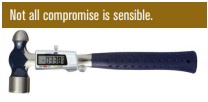When I was a small kid, whenever there was a discussion or disagreement about what was happening, my mother would say “Well, we will compromise and do it my way.” It was years before I learned that this is not really what “compromise” means. I guess it’s a quote from somewhere but I’ve been unable to trace it.
Refrigeration is full of compromises. Even the basic vapor compression cycle is less than ideal in order to make it practical. Everyone knows that the best that can be hoped for in extracting heat from a substance to cool it below ambient temperature is the Carnot efficiency; the ratio of heat extracted to work done under ideal conditions. A Carnot cycle; however, would require isentropic compression of a two-phase fluid, which is not really feasible. The Perkins cycle (what we all use, sometimes calling it the reverse-Rankine cycle) is a practical adaptation of Carnot, with the liquid phase evaporated to dryness so that the compressor is protected from the effects of ingesting liquid, which is “incompressible.” If we can’t have isentropic compression of a gas-liquid mixture, then isothermal compression would be nice, enabling more efficient operation. However, this too is sacrificed in order to provide a polytropic compressor that is both simple and reliable, hopefully without losing too much efficiency.
Compromise abounds even before the refrigerant reaches the compressor. If evaporators were truly “countercurrent,” or counterflow, then better efficiency could be achieved and if non-azeotropic fluids were used then further advantage could be gained by taking the benefit of the temperature glide on board. This would be like starting to climb the stairs from the third or fourth step. However, such evaporators, although theoretically possible, would be bulky and expensive so usually a more compact cross-flow design is used. This has become more important in recent years with the resurgence of transcritical CO2 systems because the gas-cooler would also benefit from a counterflow design. In a few cases a tube-in-tube arrangement can be used for water-cooled gas-coolers, but usually for air-cooled designs cross-flow is the norm. The change in gas temperature is sufficiently large for the cross-flow element to be minimized, so again the compromise is accepted unchallenged in most cases.
When evaporators are used to provide superheated gas to the compressor inlet for added reliability a further compromise is required. An air-cooler is a pretty poor way of providing gas heating and often up to one third of the total surface area is required for superheating the suction gas. What’s even worse is that the only way to get enough temperature difference to provide the necessary gas heating is to lower the suction temperature, making the plant even less efficient. If the refrigerant is a non-azeotrope then temperature glide adds insult to injury; the suction pressure has to be even lower to get enough superheat into the gas.
Even more compromise is evident in the expansion process. This was called the “internal hemorrhage” of the refrigeration cycle by Professor Gustav Lorentzen because it bleeds away efficiency without even being noticed. Ideally, the Perkins cycle should use an expansion engine,capable of handling two-phase flow and with capacity modulation to match the compressor in part-load operation. In practice the expansion device is normally no more sophisticated than a hole in a metal disc. Yet again, efficient operation is sacrificed to gain lower capital cost.The unusual physical properties of transcritical CO2 are also drawing attention to more efficient expanders but cost and complexity are still big challenges.
One of the most fascinating aspects of working in refrigeration is the way in which the balance of factors that drive these compromises is constantly shifting. That’s what keeps things interesting; long may it continue!

